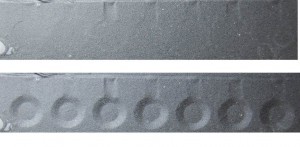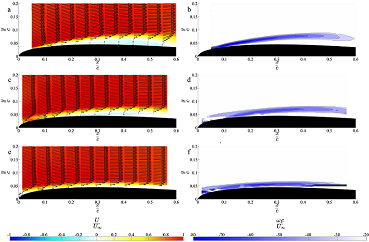Electroactive polymers (EAP, Figure 1) are used to achieve distributed conformal actuation of aerodynamic surfaces, promote transition in places where separation occurs and maintain laminar flow where there is no separation. The motivation behind the current work is using EAPs to control the boundary layer on micro air vehicles (Figure 2) to help improve their range and endurance.

Figure 1: EAP actuator; baseline (top) and activated (bottom)

Figure 2: Representation of EAPs on a Micro Air Vehicle
In this work, the feasibility of EAPs in mitigating a laminar separation bubble on a 2-D airfoil was examined. A row of EAP’s were mounted near the leading edge of the model and actuated at various driving frequencies and input voltages. Measurements, using stereoscopic particle image velocimetry (SPIV) were conducted over the upper sufrace of the model, which showed a significant reduction in the size and extent of the separation bubble (Figure 3).
The flow in the plot is from left to right and the tunnel velocity is 2.1m/s while the plate is mounted at zero degrees angle of attack. The colors represent total velocity with red being 2.6m/s and dark blue zero m/s. The black line outlines the edge of the flat plate, you can see in the baseline case separated flow region from about 15mm to 50mm. When looking at the forced case with a driving frequency of 350Hz (which corresponds to the frequency of the mixing layer) the bubble is significantly reduced. This preliminary data shows promising results in minimizing the separation bubble when the EAPs are driven at the appropriate voltages and frequencies.


EAPs forced and unforced